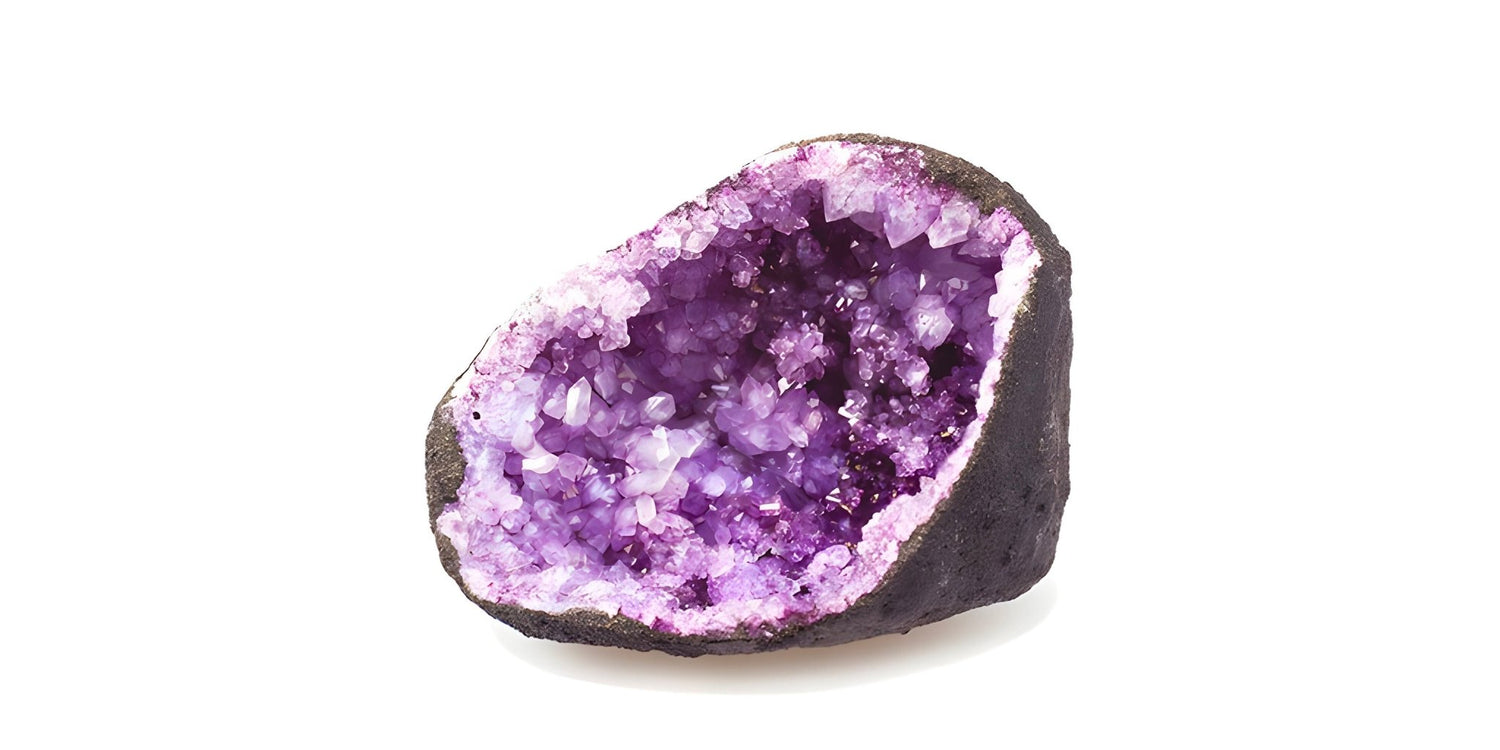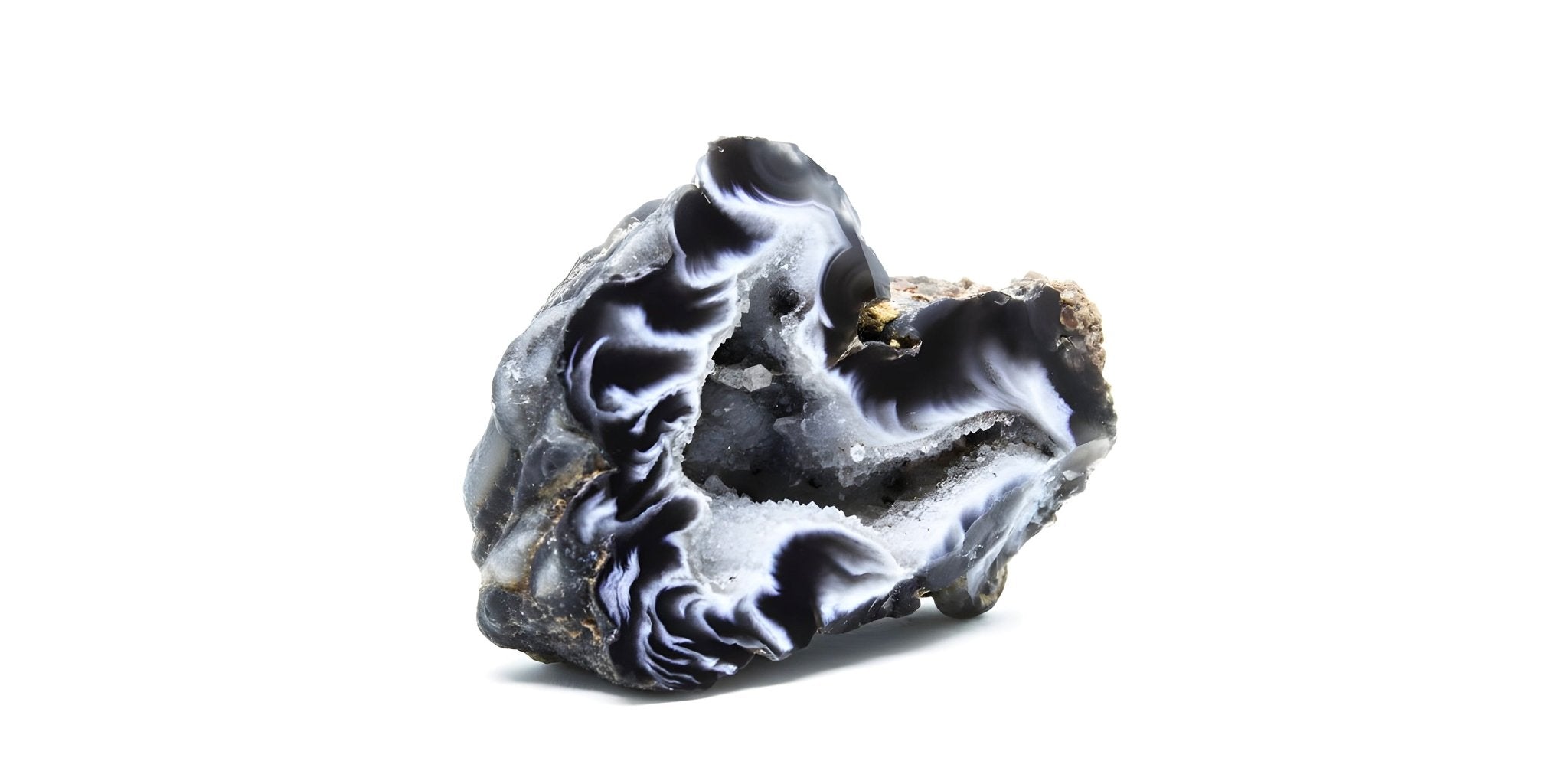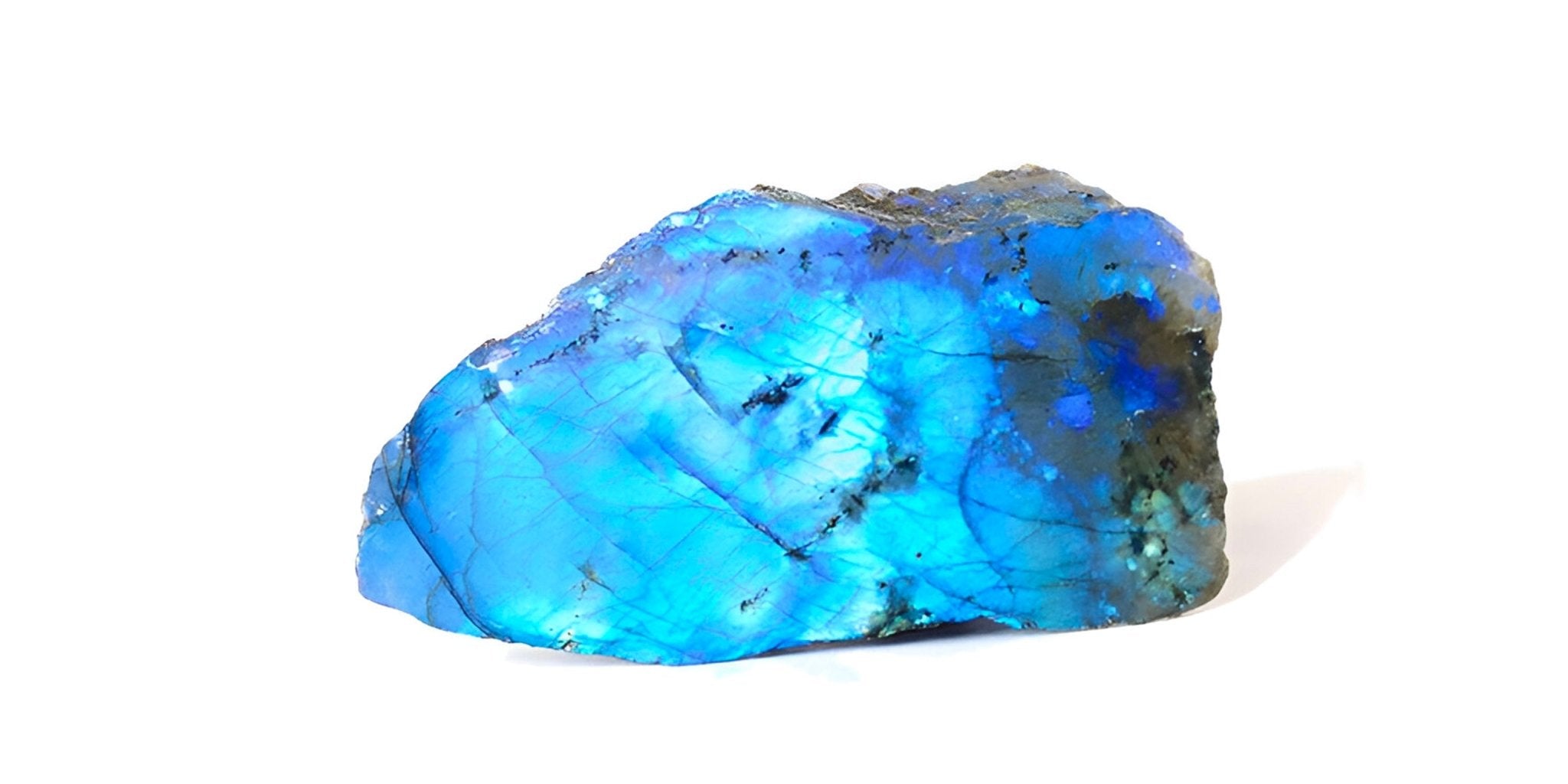Amethyst Stone Identity Sheet
- Name Origin: The name "onyx" comes from the Greek word "onux," meaning "nail" or "claw." Legend has it that Cupid cut the divine nails of Venus with an arrow while she slept, and the gods transformed these nails into onyx stone so that a part of the divine body would remain eternal on Earth.
- Group: Onyx belongs to the chalcedony family, which is a type of siliceous quartz.
- Chemical Composition: The chemical formula of onyx is SiO₂ (silicon dioxide), with possible inclusions of iron oxides and other minerals that create its characteristic color bands.
- Crystalline System: Onyx crystallizes in the trigonal crystalline system. It is mainly formed by the accumulation of layers of chalcedony alternating with microcrystalline quartz.
- Hardness: Onyx has a hardness of 6 to 7 on the Mohs scale, making it relatively resistant to scratches and scuffs.
- Deposits: Onyx deposits are found in various parts of the world, notably in Brazil, India, Madagascar, Mexico, Uruguay, and the United States.
- Color(s): Although traditionally known for its black color or black with white bands, onyx can also display layers of red, brown, white, and gray.
- Chakras: Onyx is often associated with the root chakra. It is believed to help with grounding, increase concentration, and protect against negative energy.
Where does the name Amethyst come from?
Etymological Origins
The name "amethyst" has its origins in Greek mythology and etymology. Derived from the Greek word "amethystos," meaning "not intoxicated" or "sober," amethyst has long been associated with the belief in its ability to protect against drunkenness. This belief is deeply rooted in ancient legends and stories, reflecting the value and importance that past cultures attributed to this precious stone.
Ancient Legends
According to a Greek legend, Dionysus, the god of wine and excess, angered by a mortal, decided to take revenge by creating tigers to pursue the first person he would meet. That person was a young girl named Amethyst, who was on her way to pay homage to the goddess Artemis. Artemis, to save her, transformed her into a statue of pure white quartz. Dionysus, repentant and in tears, poured wine over the statue, which absorbed the purple color of the wine, thus creating amethyst.
This story not only illustrates the mythological origin of the name but also highlights the stone's association with sobriety and protection. It sheds light on the ancient belief that wearing an amethyst could prevent intoxication and promote mental clarity.
Symbolism and Historical Uses
The connection between amethyst and sobriety goes beyond mere legend. In ancient times, both Greeks and Romans often wore amethyst amulets or drank from goblets decorated with this stone, firmly believing it would protect them from the harmful effects of alcohol. This practice was so widespread that even today, amethyst symbolizes sobriety and temperance.
In the Middle Ages, amethyst acquired a deeper spiritual significance, becoming a stone of importance within the Christian Church. Bishops frequently wore rings adorned with amethyst, the stone symbolizing piety, humility, and spirituality. This reflected the belief that amethyst could promote clarity of spiritual mind, helping wearers remain free from earthly thoughts and temptations.
Amethyst Today
Today, amethyst continues to be a highly prized gemstone, not only for its beauty but also for its symbolic associations with clarity, sobriety, and protection. It is used in jewelry, decoration, and in spiritual and healing practices. The legends and beliefs surrounding amethyst enrich its history, transforming each stone not only into an object of natural beauty but also into a symbol carrying deep and ancient meanings.
In short, the name "amethyst" is a legacy of ancient beliefs and practices, a word that encapsulates centuries of legends, spirituality, and magic. This stone remains a tangible link to the past, a window into the beliefs and values of the civilizations that revered it.
What is the history of the Amethyst stone?
Origins and Etymology
Amethyst, with its captivating violet hue, is one of the most revered gemstones throughout history. Its name, derived from the Greek word "amethystos," meaning "not intoxicated," evokes ancient legends linked to sobriety and clairvoyance. This etymology reveals one of the earliest and most enduring beliefs associated with amethyst: its ability to protect against drunkenness and promote clarity.
Mythological Legends
Greek mythology is full of stories illustrating the divine origin of amethyst. One legend tells that Dionysus, the god of wine, intoxication, and theater, angered by a human insult, decided to take revenge by killing the first mortal he encountered. A young maiden named Amethyst, on her way to worship the goddess Artemis, was the unfortunate one. To save her, Artemis transformed her into a statue of pure crystal. Dionysus, moved by the girl's beauty and piety, poured wine over the statue, thus tinting the crystal purple. This tale illustrates the duality of amethyst: a stone of sobriety born from excess.
Symbolism Through the Ages
Over the centuries, amethyst has acquired a profound spiritual significance. In ancient Egypt, it was used in amulets and talismans to protect against dangers and diseases. Egyptians also believed that amethyst helped soothe emotions and promote mental clarity.
In medieval Europe, amethyst became a symbol of royalty and piety. It adorned crowns, scepters, and ecclesiastical jewelry, symbolizing the divine connection. Christian bishops often wore amethyst rings, believed to promote chastity and ward off earthly thoughts. This stone was also thought to protect soldiers and help hunters capture their game.
Amethyst in Modern Cultures
In contemporary times, amethyst continues to fascinate, not only for its natural beauty but also for its reputed healing properties. It is considered a stone of meditation and calm, capable of soothing the mind, encouraging spiritual elevation, and strengthening intuition. Amethyst is also associated with the higher chakras, believed to facilitate spiritual communication and the opening of consciousness.
Natural Reserves and Extraction
The main amethyst deposits are found in Brazil, Uruguay, Russia, and Africa. The extraction of amethyst dates back thousands of years, but it was from the 17th century, with the discovery of rich deposits in Brazil, that its availability increased, making the stone accessible to a wider audience. Extraction methods have evolved, but the respect for this stone and its beauty remains unchanged.
A Stone of Mystery and Beauty
The history of amethyst is woven with myths, spirituality, and royalty. Each era and culture has contributed to enriching the story of this precious stone, attributing powers and meanings to it that transcend its physical appearance. Amethyst, more than just a gem, is a bridge between past and present, offering a window into the beliefs and values of vanished civilizations while continuing to influence contemporary spiritual and aesthetic practices.
What is the origin and composition of the Amethyst stone?
Amethyst, with its captivating violet hue, is one of the most sought-after gemstones worldwide. Its color, ranging from soft lilac to deep purple, has fascinated humanity since Antiquity. But beyond its beauty, the origin and chemical composition of amethyst reveal a fascinating geological journey.
Geological Origin
Amethyst belongs to the quartz family, one of the most abundant minerals in the Earth's crust. It forms in the cavities of igneous rocks, where hydrothermal solutions rich in silica crystallize under the effect of temperature and pressure. These cavities, or geodes, provide the necessary space for amethyst crystals to grow in size and beauty.
The formation of amethyst can take millions of years, a slow process during which the temperature, pressure, and chemical composition of the parent solution vary, influencing the color and quality of the crystals formed. The largest amethyst deposits are found in Brazil, Uruguay, Russia, and Africa, where unique geological conditions have favored the formation of this precious stone.
Chemical Composition
The chemical formula of amethyst is SiO₂, identical to that of clear quartz. What distinguishes amethyst and gives it its characteristic color is the presence of traces of iron (Fe³⁺) and, in some cases, other trace elements such as manganese. When quartz is exposed to ionizing radiation, these trace elements interact with silicon and oxygen to produce the characteristic range of violets found in amethyst.
Temperature Influence
A fascinating aspect of amethyst's composition is its sensitivity to temperature. At temperatures above approximately 300-400°C, amethyst can lose its violet color and become yellow or colorless, a phenomenon that has led to the creation of certain varieties of artificially heated quartz to imitate other gemstones.
Varieties and Characteristics
In addition to its main color, amethyst can display variations such as ametrine, a bicolored stone that blends purple amethyst and yellow citrine, due to the differential distribution of temperatures and chemical elements during crystal formation. This diversity adds to the value and appeal of amethyst as a gemstone.
A Jewel of Nature
The origin and composition of amethyst tell the story of a millennia-old transformation, from the depths of the earth to the brilliance of jewelry. The unique combination of geological conditions required for its formation makes each stone a testament to the natural history of our planet. More than just a gem, amethyst embodies the beauty and mystery of earthly creation, making it a precious stone both for its splendor and for the window it opens onto the Earth's geological past.
What are the benefits of Amethyst stone (physical and psychic)?
Amethyst, with its distinctive violet color ranging from light lilac to deep purple, is one of the most valued and widely used gemstones in lithotherapy. Recognized not only for its beauty but also for its many physical and psychic benefits, amethyst is considered a stone of protection, purification, and spirituality. Here is a detailed overview of its multidimensional benefits.
Psychic and Emotional Benefits
Promoting Serenity and Balance
Amethyst is widely renowned for its soothing properties. It helps to calm the mind, promoting a state of serenity that is beneficial for meditation and concentration. This stone is also used to balance emotions, reducing anxiety and stress.
Strengthening Intuition
Associated with the third eye chakra, amethyst is said to stimulate intuition and enhance psychic abilities. It opens the mind to new ideas and deeper awareness, allowing for better self-understanding and perception of one's environment.
Aid for Sleep and Dreams
Amethyst also has a reputation as a stone that promotes restful sleep and lucid dreams. By placing an amethyst under the pillow or near the bed, many people report improved sleep quality, fewer nightmares, and an increased ability to remember their dreams.
Physical Benefits
Purification and Protection
Amethyst is known for its purifying properties. It can help cleanse the body of toxins and strengthen the immune system. Additionally, this stone is often used to protect against negative energies and harmful external influences.
Support in Treating Addictions
True to its etymology, which means "not intoxicated," amethyst is traditionally considered helpful in treating addictions and compulsive behaviors. It is said to help clarify the mind and strengthen willpower, thus supporting individuals in overcoming their dependencies.
Benefits for the Skin and Endocrine System
On a physical level, amethyst is believed to have beneficial effects on the skin, helping to maintain its overall health and reduce acne. It is also associated with hormone regulation, potentially offering support for imbalances in the endocrine system.
A Multidimensional Gem
The virtues of amethyst encompass a wide range of physical and psychological benefits, making it a particularly versatile and valuable stone in healing and wellness practices. Whether for its enchanting beauty or its healing properties, amethyst remains a preferred stone for many people seeking balance, protection, and spiritual elevation. Its role in lithotherapy and spiritual beliefs throughout the ages attests to its special place in the human heart and mind.
How to care for your Amethyst stone jewelry?
Amethyst jewelry, with its captivating violet shine, is not only an exquisite fashion accessory but also a talisman for spiritual and emotional well-being. To preserve its beauty and energy, special care is essential. Here is how to care for your amethyst jewelry, along with an invitation to discover our collections of bracelets for women and men, which combine aesthetics with therapeutic benefits.
Amethyst Cleaning
Gentleness and Care
Although amethyst is a relatively hard stone, it can be damaged by chemicals or extreme temperatures. To clean your amethyst jewelry, use lukewarm soapy water and a soft brush. Avoid abrasive cleaners that could scratch the surface of the stone.
Drying and Polishing
After cleaning, carefully dry your jewelry with a soft cloth to prevent any water from seeping into the settings. For extra shine, you can gently polish the stone with a microfiber cloth.
Recharging and Purification
Solar and Lunar Energy
Exposure to natural light can recharge your amethyst and renew its energy. However, avoid prolonged exposure to direct sunlight, which can dull the color of the stone. Moonlight, especially during a full moon, is ideal for gentle recharging.
Natural Methods
You can also purify your amethyst by placing it on a cluster of quartz or submerging it in sea water. These natural methods help cleanse the stone of negative energies and restore its natural balance.
Proper Storage
Scratch Protection
Keep your amethyst jewelry in a soft case or individual pouch to protect it from scratches. Gemstones can scratch each other, so it is important to separate or wrap them individually.
Protected from Humidity
Humidity can damage your amethyst jewelry over time. Be sure to store them in a dry place, away from moisture and temperature fluctuations.
Discover Our Collection
Amethyst Stone Bracelets for Women
Our collection of amethyst bracelets for women is designed to combine elegance and well-being. Each piece is selected for its quality and beauty, offering a touch of refinement to your daily life while benefiting from the soothing properties of amethyst.
Amethyst Stone Bracelets for Men
Explore our range of amethyst bracelets for men, perfect for those seeking both style and substance. Our bracelets are designed to accompany the modern man in his quest for balance and inner strength.













